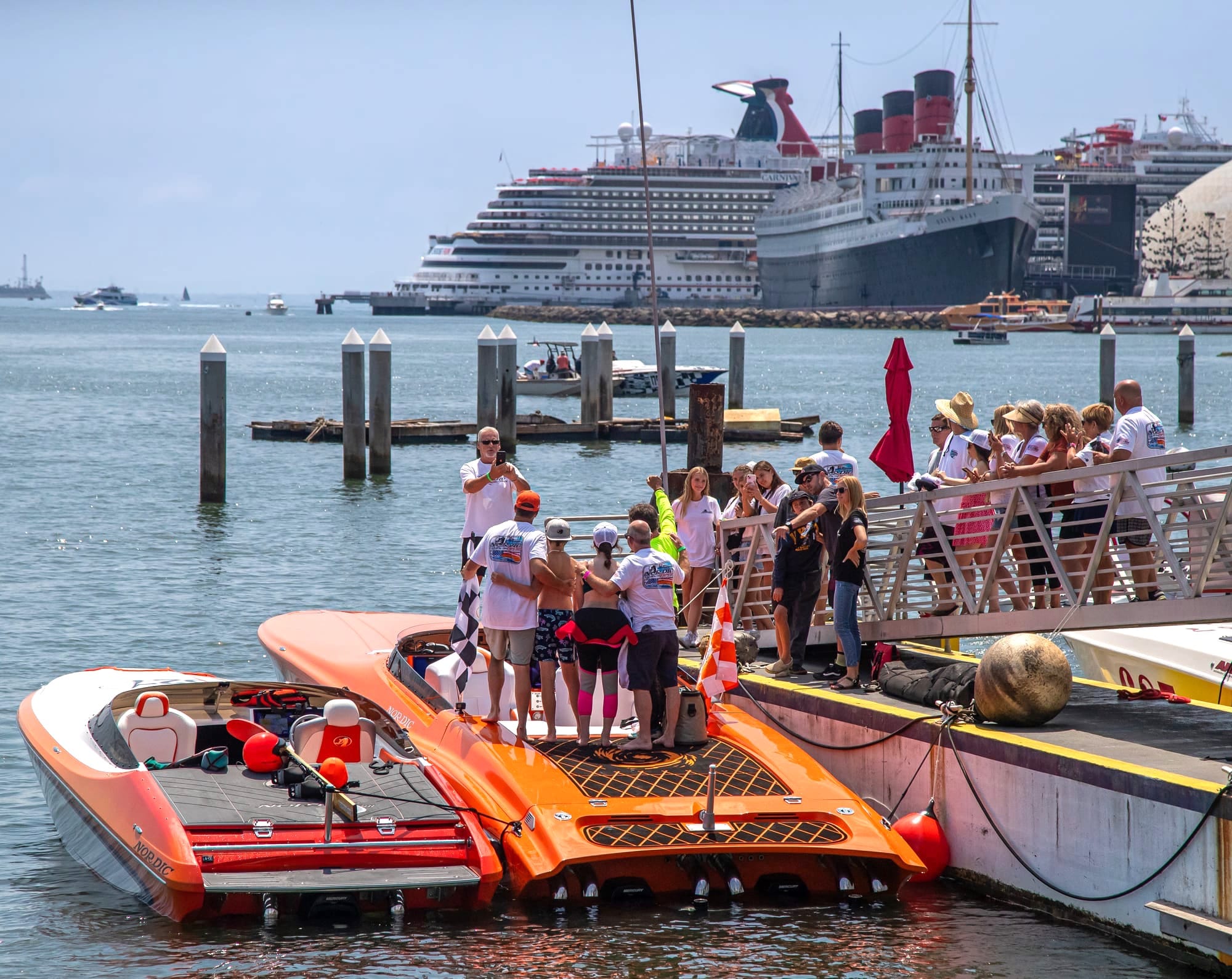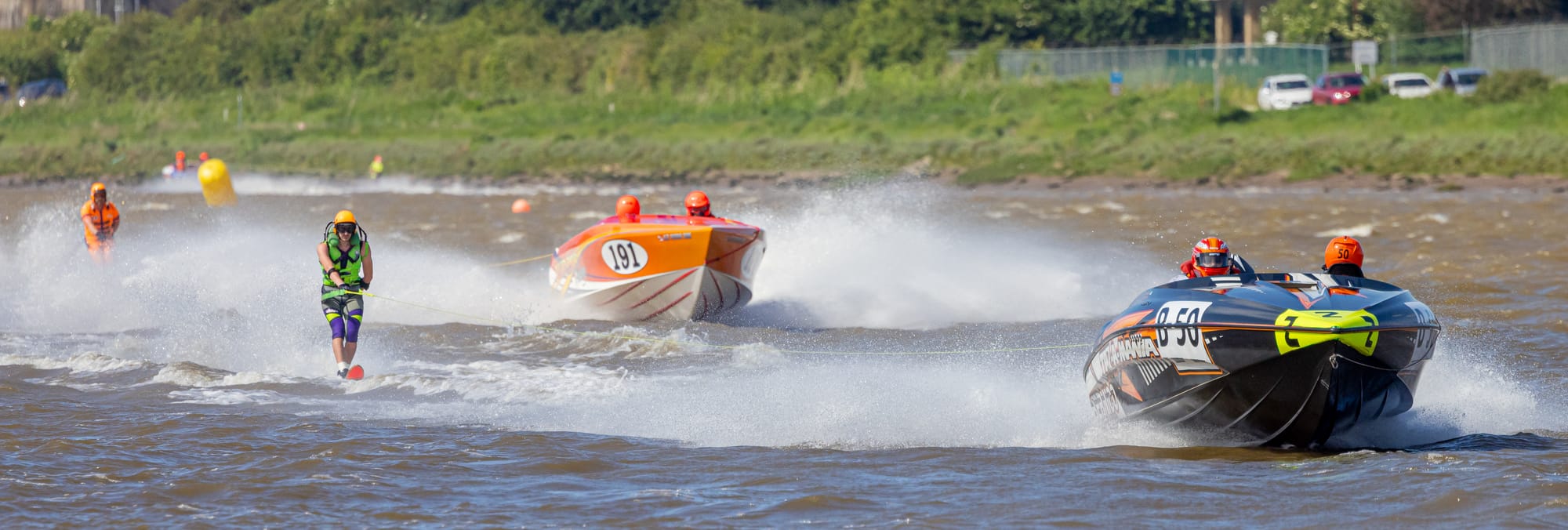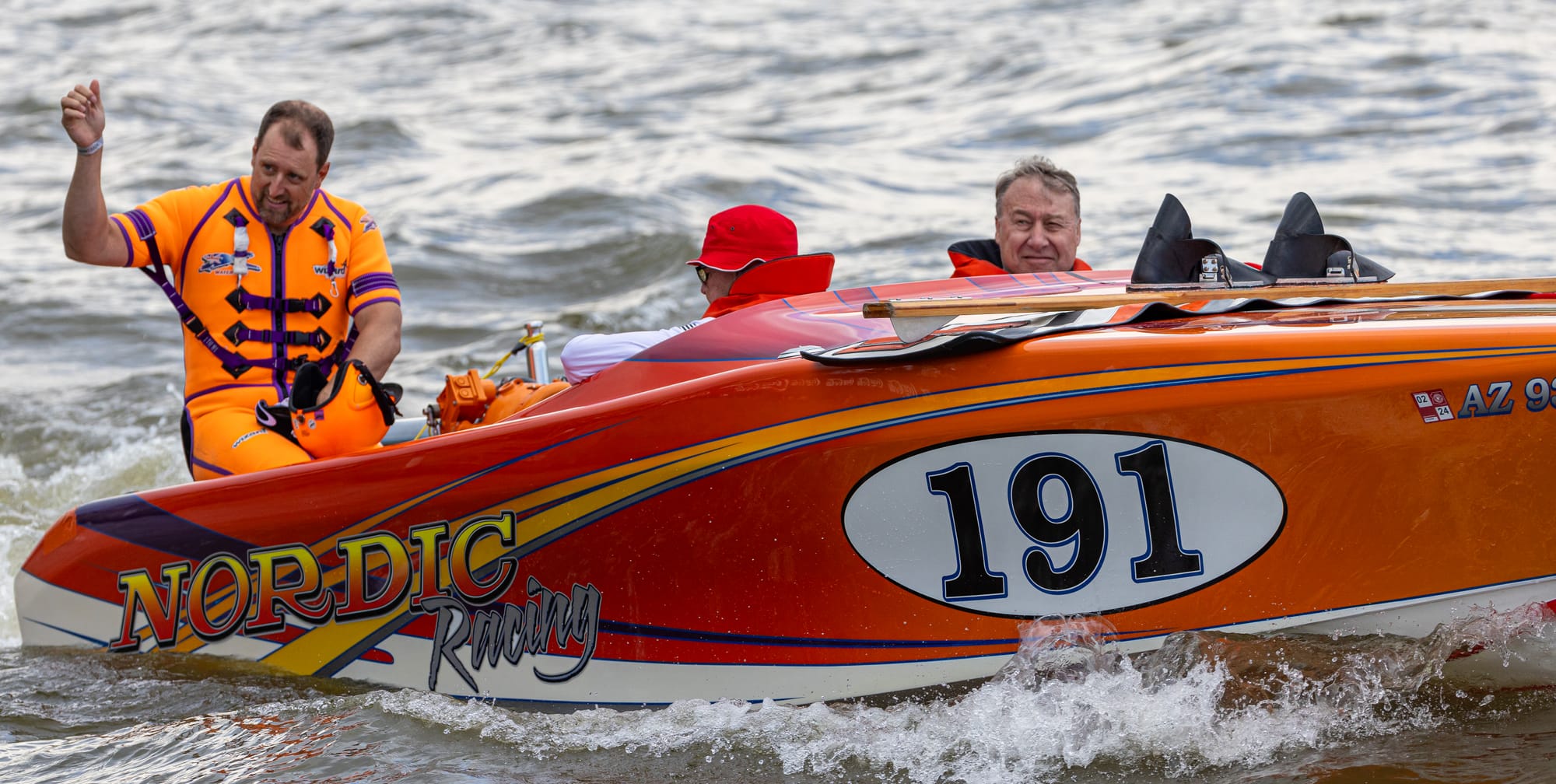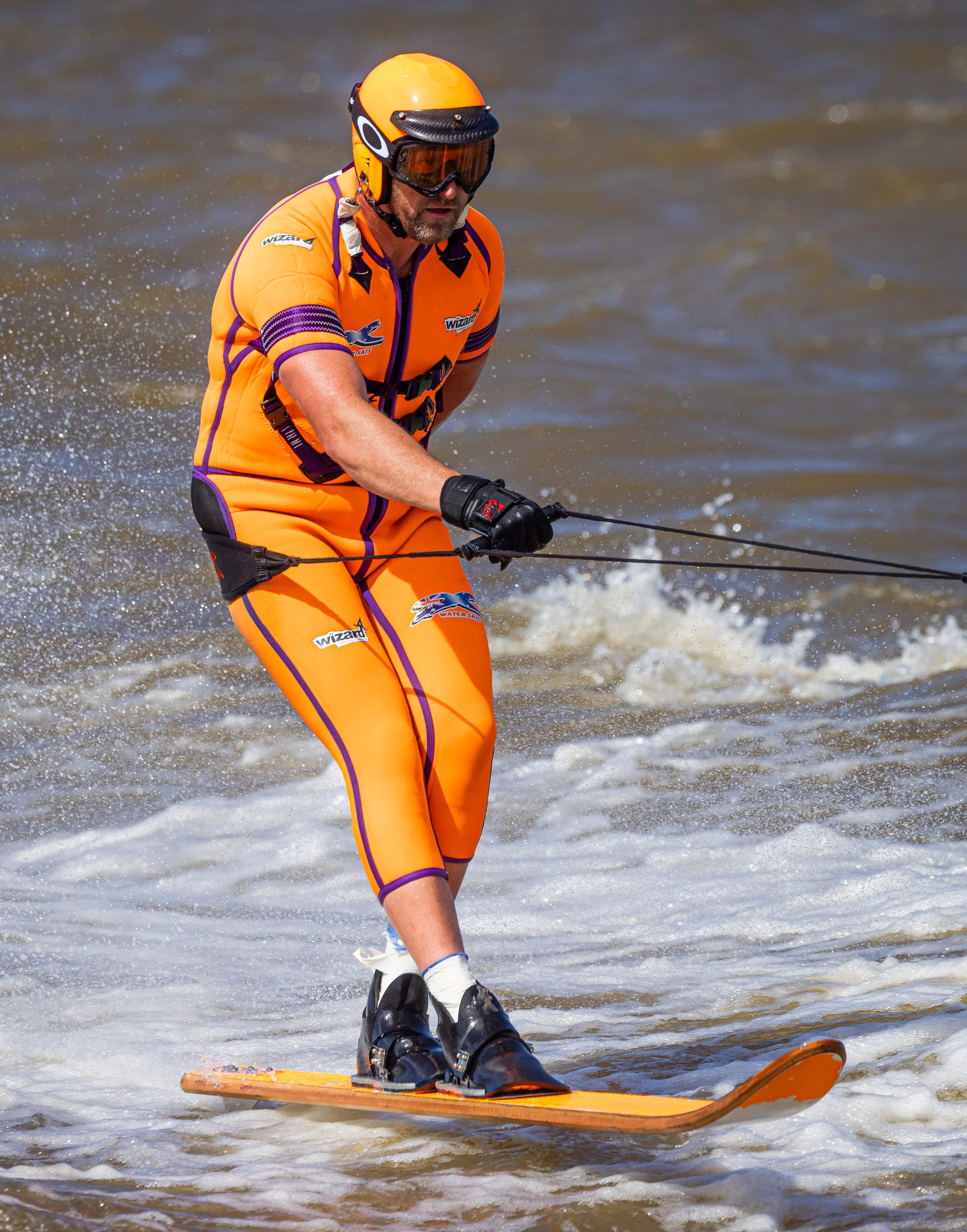
Think of a town or landmark 62 miles from your home.
For scale, that’s almost the distance from Malibu to Newport Beach. Or Boston to Providence (plus another 11 miles), or suburban Denver all the way up I-70 to Frisco. Good. Now strap into your helmet and tow rope, add in currents and creatures of the Pacific, and water ski those 62 miles at speeds of up to 90 miles an hour.
That’s the Catalina Ski Race, a 75-year-old all-out odyssey in which water ski teams from around the world race each other starting near the Queen Mary in Long Beach, California, across the open ocean to the southeast coast of Catalina Island, and back to Long Beach.
Todd Haig and his team won that race in the Men’s Open class this summer, just as they did in 2022, 2021 and another 14 times since 2000. With 17 titles, Haig is the most decorated Catalina racer in history, and it’s not even close. According to the Catalina Ski Race Hall of Champions, Chuck Stearns comes next with 11 wins between 1955 and ’82.
Haig, 44, is the first to say that part of his dominance and longevity is due to skiing with the same teammates for 20 years: driver Randy Davis, observer Dennis Hall, and navigator Steve Davis.
They don’t have secret signals to communicate out on the water, aside from Haig waving up, down, or OK for boat speed. But they do have familiarity and trust.
“I have to know the driver is reading the water as best he can and he knows enough to make adjustments — oh these waves are pretty big, I need to slow it down here,” Haig says. “He’s our first line of defense. The observer feels the conditions through the boat and can read how I handle them and then communicate to the driver. Everyone is working in unison to make it happen.”
Still, out in the sunshine and saltwater, it’s Haig’s legs that absorb the water’s force for 52 minutes and 40 seconds, his lower back that holds the bent-over ski stance, his arms and shoulders that keep the rope taut.
As his friend and fellow high-octane sportsman Glen Plake puts it, “Haig is an absolute animal of fitness and danger.”
Once upon a time, he was just a wee one enjoying the water. Haig’s parents had a place in Parker, a community on the California side of the Colorado River just south of Lake Havasu — a mecca for water activity of all kinds. Every weekend, the Haigs loaded up the dually and drove from their Banning, California home two-and-a-half hours to get to the river.

“That’s where I started getting dragged behind the boat at a very young age.”
Just four years old, in fact. He entered his first race at age seven and came in seventh place if he remembers correctly. Some kids might have pouted at that kind of finish, but race organizers must have known what they were doing: “They gave me a really big trophy, so I thought that was really cool, and it hooked me from there.”
He continued to compete in regional races and even tried slalom and “trick” skiing. But racing and the racing community suited Haig and his family best, and before long, Haig started to not only win but show potential as an elite skier.
“I think I was like 9 or 10 when we took our first trip to Australia for the national championships. We met friends there and pretty much started going back every November.”
He recognizes how big of a commitment it was for his parents and family.
“With no return on investment. It was all just for a trophy and a high five. But you couldn’t beat the family time it brought, the hours spent in the truck riding together, talking to each other and hanging out.”
He was just nine the first time he did Catalina, too, earning him the trophy for the youngest skier that year. In his early teens, he started paying attention to the guys winning big races and thought to himself, I want to do that too someday.
At 15, he went to Belgium for his first Junior World Championships, where he didn’t do very well but saw firsthand how he stacked up against the world’s best.
“I started wanting to compete. Wanting to be a world champion. And to get there, it was mainly all about fitness and lots of water skiing. There weren’t coaches to help you.”

He put in the work, and it paid off. At 17, he was selected as an alternate to represent Team USA in Australia at the 1997 Water Ski Racing World Championships, held every two years. One of the American skiers broke his leg in the first race, so Haig skied the next three, finishing in the top 20.
He qualified for Worlds again two years later, this time in Spain, where he skied behind his dad and finished sixth overall. The trajectory seemed promising for Haig and his dad during the next World Championships, in Las Vegas in 2001. But boat trouble and a crash derailed not only the race but, for a time, water skiing altogether.
“It was one of those perfect storms where it all fell apart for us.”
His dad quit driving, and Haig pulled away from the sport.
He didn’t compete for two years; instead, he go-karted and poured the rest of his time into learning about his dad’s framing and lumber business in Redlands.
His first dip back into racing came when a friend asked him to be an observer, but that didn’t suit him. He remembers thinking, “If I’m going to be here, I need to ski.”
With that clarity, he devoted a new commitment to his fitness, skiing and a world title. And this time, when he and his new team qualified for the World Championships in 2005 in England, they won all four races.

That team has been together ever since, winning all those Catalina races and more. This summer, they also won The Diamond Race in Belgium in the F1 Men’s class, earning Haig proper respect and recognition in U.K. Waterski Racing’s post-race Instagram post: “Todd Haig, The King of the Canal, Officially breaking The Diamond Race record and being 6 times Formula 1 Champion 🏆.”
Set in a narrow shipping canal, that race is a whole different beast than Catalina. Teams race laps in a course that Haig estimates is maybe two miles long and 300 feet wide, and with 35 boats sharing such small space, conditions get dicey.
“It’s really great for spectating — the crowd is maybe eight feet above the water, and you can almost reach your hand out and give racers a high five. But the water never gets a chance to dissipate. It’s like an old-school washing machine, with agitators in there and splashing back. It becomes a survival thing.”
Which brings us back to Haig’s command of fitness and danger.

You might think it takes some sort of thrill-seeking gene to ski at freeway speeds in open-ocean or washing-machine conditions. Even on the water, a crash at 80 or 100 miles an hour can cause serious and permanent injury — the neck, arms and shoulders are particularly vulnerable.
But for Haig, it’s not about living on the edge (anymore). It’s more about calculating the risk and preparing as best he can to ski as fast and safely as possible.
“I used to do base jumps. That would be more seeking danger. You need to know it’s there, but I hate when people think that’s all it’s about, and I’d hate to deter anyone.
“The best safety is your fitness and your team looking out for you. They know when you’re on a good day and can push, and if not, that’s the day you maybe need to be satisfied with what you can get done and try again later.”
These days, fitness wedges into whatever openings work and family life allow. Since his dad’s passing in 2009, Haig now runs Hondo Framing, which affords him some flexibility, yes, but also all of the responsibility.
During race season, he tries to make the hour-and-a-half drive from Redlands to Long Beach to ski before work a couple of days a week, and then hit the gym or mountain bike trails after work —and after school. His oldest son Tanner, 13, races jet skis and is now old enough to train, too.
Family time.

“I save some of that stuff for when he gets out of school so I can do it with him. We’ll go do a training session or a mountain bike ride, and it’s fun. We’ve just had some fun times together.”
Tanner skied the Catalina race this year for the first time. He competed in the “over and back” class, splitting the race into two legs — one for him and one for his partner, Darcy Manchett, daughter of multi-time World Champion and Catalina Champion Kim Lumley.
Guess who won the trophy for youngest skier, just like his dad?
“That was pretty cool,” Haig says. “Right now, he’s just enjoying it and seeing if he wants to do it next year.”
